The Hunted (William Friedkin, 2003)
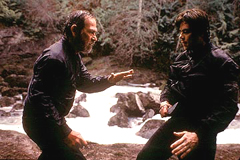 Unlike most action movies, when the characters in William
Friedkinís The Hunted bleed, sweat, and scar, one canít help but
notice. Thereís an emphasis on the physicality of the actors here that
elevates some of the scenes above the filmís generally uninspiring intentions.
Essentially an excuse to stage an extended chase scene, the plot finds a retired
wilderness tracker named Bonham (Tommy Lee Jones) brought back into the fold by
the FBI in order to capture Aaron Hallam (Benicio Del Toro), a professional
assassin he trained personally. Apparently, ďirreversible battle stressĒ has
turned Hallam into a killing machine, but the film insists on fleshing out his
character past the point of usefulness so it can set up rather moribund father /
son and teacher / protťgť parallels. For some reason, Friedkin also feels it
necessary to introduce us to Hallamís ex-girlfriend and have characters offer
several theories on his insanity. Since the threat of a fall into madness
matching Hallamís never seems to exist in Bonham, these rudimentary
explanations of Hallamís progression into psychosis donít serve much purpose
in helping to understand the dynamic between the two lead characters.
Unlike most action movies, when the characters in William
Friedkinís The Hunted bleed, sweat, and scar, one canít help but
notice. Thereís an emphasis on the physicality of the actors here that
elevates some of the scenes above the filmís generally uninspiring intentions.
Essentially an excuse to stage an extended chase scene, the plot finds a retired
wilderness tracker named Bonham (Tommy Lee Jones) brought back into the fold by
the FBI in order to capture Aaron Hallam (Benicio Del Toro), a professional
assassin he trained personally. Apparently, ďirreversible battle stressĒ has
turned Hallam into a killing machine, but the film insists on fleshing out his
character past the point of usefulness so it can set up rather moribund father /
son and teacher / protťgť parallels. For some reason, Friedkin also feels it
necessary to introduce us to Hallamís ex-girlfriend and have characters offer
several theories on his insanity. Since the threat of a fall into madness
matching Hallamís never seems to exist in Bonham, these rudimentary
explanations of Hallamís progression into psychosis donít serve much purpose
in helping to understand the dynamic between the two lead characters.
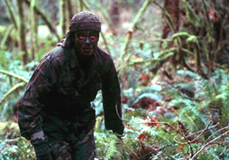 Fortunately, the filmís centerpieces, the two mano-a-mano
confrontations between Tommy Lee Jones and Benicio Del Toro, are stunning. The
scenes leading up to the first, which follow Bonham as he tracks through the
woods, observing the ďcluesĒ that Hallam has left behind, are of the most
exciting type of movie detective work. When the hunter and hunted finally meet,
their dialogue is delivered in the midst of a remarkably tense bout of
grappling. The violence is brutal, and to make it have even more impact,
Friedkin adds CGI-enhanced arterial sprays when blood starts spurting. The
actors internalize a lot of their performances throughout, but when they tussle,
they express everything they havenít been saying. Their muscles bulge, they
make exhausted grunts, and the soundtrack becomes an ambient electronic buzz.
Their final confrontation, staged near a waterfall, is not nearly as exciting as
their first meeting, but it still shines. Additionally, thereís a great
vivisection training flashback that had me squirming in my seat despite a lack
of bloodshed.
Fortunately, the filmís centerpieces, the two mano-a-mano
confrontations between Tommy Lee Jones and Benicio Del Toro, are stunning. The
scenes leading up to the first, which follow Bonham as he tracks through the
woods, observing the ďcluesĒ that Hallam has left behind, are of the most
exciting type of movie detective work. When the hunter and hunted finally meet,
their dialogue is delivered in the midst of a remarkably tense bout of
grappling. The violence is brutal, and to make it have even more impact,
Friedkin adds CGI-enhanced arterial sprays when blood starts spurting. The
actors internalize a lot of their performances throughout, but when they tussle,
they express everything they havenít been saying. Their muscles bulge, they
make exhausted grunts, and the soundtrack becomes an ambient electronic buzz.
Their final confrontation, staged near a waterfall, is not nearly as exciting as
their first meeting, but it still shines. Additionally, thereís a great
vivisection training flashback that had me squirming in my seat despite a lack
of bloodshed.
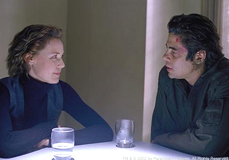 When the movie isn't playing Best Supporting Actor Oscar
Winner Deathmatch, however, it's more of a snooze. The chase scenes are a long
buildup to the confrontational payoffs, and the dialogue-filled expositional
sequences seem worse here than in your average action flick since the action
here manages to be so intermittently astounding. Connie Nielsen has no place
here as a gun-toting FBI agent, and as much as thatís the thematic point of
her inclusion, thereís no escaping the fact that her character exists mostly
to pad out the running time. I was entirely impatient with the jurisdictional
dick-measuring contest that went on between the various local and federal
agencies just as the explanation of Hallamís motive generally bored me. Most
of the chase scenes arenít especially exciting either, since Hallam leaves a
lot of clues and acts fairly stupidly for a trained expert focused entirely on
his imaginary mission. The downtown Portland tracking sequence is ridiculous no
matter how many times Friedkin tries to convince us that the city is an
extension of nature because it relies on such sloppiness in the prey.
When the movie isn't playing Best Supporting Actor Oscar
Winner Deathmatch, however, it's more of a snooze. The chase scenes are a long
buildup to the confrontational payoffs, and the dialogue-filled expositional
sequences seem worse here than in your average action flick since the action
here manages to be so intermittently astounding. Connie Nielsen has no place
here as a gun-toting FBI agent, and as much as thatís the thematic point of
her inclusion, thereís no escaping the fact that her character exists mostly
to pad out the running time. I was entirely impatient with the jurisdictional
dick-measuring contest that went on between the various local and federal
agencies just as the explanation of Hallamís motive generally bored me. Most
of the chase scenes arenít especially exciting either, since Hallam leaves a
lot of clues and acts fairly stupidly for a trained expert focused entirely on
his imaginary mission. The downtown Portland tracking sequence is ridiculous no
matter how many times Friedkin tries to convince us that the city is an
extension of nature because it relies on such sloppiness in the prey.
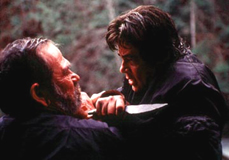 Technically, The Hunted features some commendable
work. The great cinematography manipulates environmental lighting to enhance our
impression of the characters. Perhaps my favorite shots in the movie occur at
the end of an extended flashback that is filmed in high contrast. At the end of
the sequence, during a close-up of Hallamís face, the lighting scheme shifts
to that of the ďpresentĒ, which is shown in the next shot with a close-up of
Bonham remembering the events shown. These two shots visually demonstrate a
connection between the two characters that unfortunately isnít expressed
elsewhere so elegantly. Itís far preferable to any of the psychobabble that
the film offers in helping to convey their relationship. The impressive
landscapes are possibly more vividly shown than either of the leads, with both
the white snow of the Canadian wilderness and the bright orange of a hunting
jacket in the green forests of Oregon looking equally stunning. The editing is
nearly as impressive. Besides maintaining a consistent rhythm, even during the
dialogue sequences, the cutting makes Hallam move faster than is humanly
possible and helps to highlight the excellent stunt work. The most impressive
moment occurs when Friedkin holds a shot long enough so we can see Bonham
leaping off of the front porch of a house. Itís only a fall of twelve feet or
so, but since the camera isnít ostentatiously trying to amp the moment up in
any way, the danger of the leap is more than apparent. The only bit of action
that looks less than convincing is an awful sequence in which an obvious CGI
Tommy Lee Jones is seen falling down a waterfall. Otherwise, the filmís focus
on the actorsí physicality pays off.
Technically, The Hunted features some commendable
work. The great cinematography manipulates environmental lighting to enhance our
impression of the characters. Perhaps my favorite shots in the movie occur at
the end of an extended flashback that is filmed in high contrast. At the end of
the sequence, during a close-up of Hallamís face, the lighting scheme shifts
to that of the ďpresentĒ, which is shown in the next shot with a close-up of
Bonham remembering the events shown. These two shots visually demonstrate a
connection between the two characters that unfortunately isnít expressed
elsewhere so elegantly. Itís far preferable to any of the psychobabble that
the film offers in helping to convey their relationship. The impressive
landscapes are possibly more vividly shown than either of the leads, with both
the white snow of the Canadian wilderness and the bright orange of a hunting
jacket in the green forests of Oregon looking equally stunning. The editing is
nearly as impressive. Besides maintaining a consistent rhythm, even during the
dialogue sequences, the cutting makes Hallam move faster than is humanly
possible and helps to highlight the excellent stunt work. The most impressive
moment occurs when Friedkin holds a shot long enough so we can see Bonham
leaping off of the front porch of a house. Itís only a fall of twelve feet or
so, but since the camera isnít ostentatiously trying to amp the moment up in
any way, the danger of the leap is more than apparent. The only bit of action
that looks less than convincing is an awful sequence in which an obvious CGI
Tommy Lee Jones is seen falling down a waterfall. Otherwise, the filmís focus
on the actorsí physicality pays off.
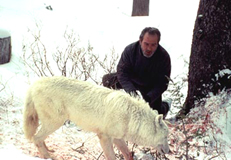 Still, it can be said that several of Friedkinís attempts to
incorporate deeper themes donít pay off. At first, his simple
metaphors seem well designed. An introductory scene in which Bonham tracks a
wounded wolf through the woods might be obvious, but itís consistent with the
movieís tone. As the film progresses, however, such continued simplicity
becomes frustrating. When Friedkin shows a group of children playing hide and go
seek or has characters discuss a cat thatís tracking its prey, the subtext
doesnít tell us anything that the text already hasnít. By the time the film
features a montage in which its hero and villain each forge a knife before their
final face-off (presumably in an attempt to demonstrate the primal nature of
their struggle), the inane symbolism seems to be overtaking the logic of the
film. Since The Hunted isnít especially hung up on logistical concerns,
this doesnít keep the film from succeeding entirely. One canít help but wish
the savagery and economy expressed in the fight scenes spilled over into the
rest of the movie.
Still, it can be said that several of Friedkinís attempts to
incorporate deeper themes donít pay off. At first, his simple
metaphors seem well designed. An introductory scene in which Bonham tracks a
wounded wolf through the woods might be obvious, but itís consistent with the
movieís tone. As the film progresses, however, such continued simplicity
becomes frustrating. When Friedkin shows a group of children playing hide and go
seek or has characters discuss a cat thatís tracking its prey, the subtext
doesnít tell us anything that the text already hasnít. By the time the film
features a montage in which its hero and villain each forge a knife before their
final face-off (presumably in an attempt to demonstrate the primal nature of
their struggle), the inane symbolism seems to be overtaking the logic of the
film. Since The Hunted isnít especially hung up on logistical concerns,
this doesnít keep the film from succeeding entirely. One canít help but wish
the savagery and economy expressed in the fight scenes spilled over into the
rest of the movie.
* * *
04-13-03
Jeremy Heilman